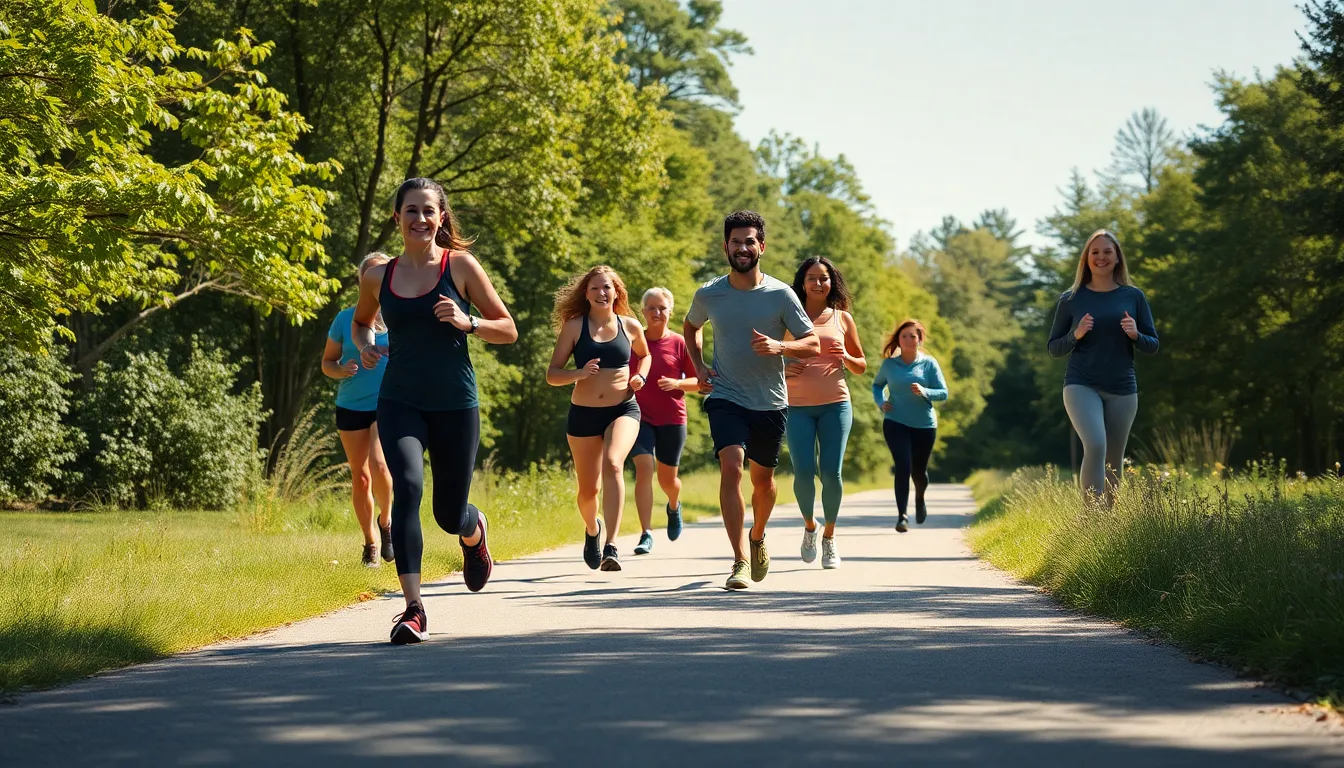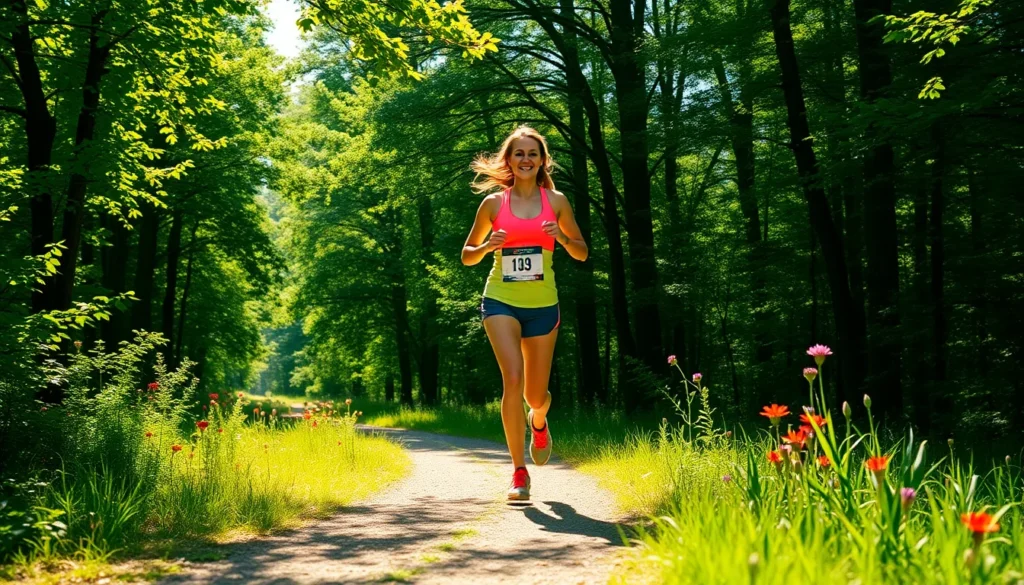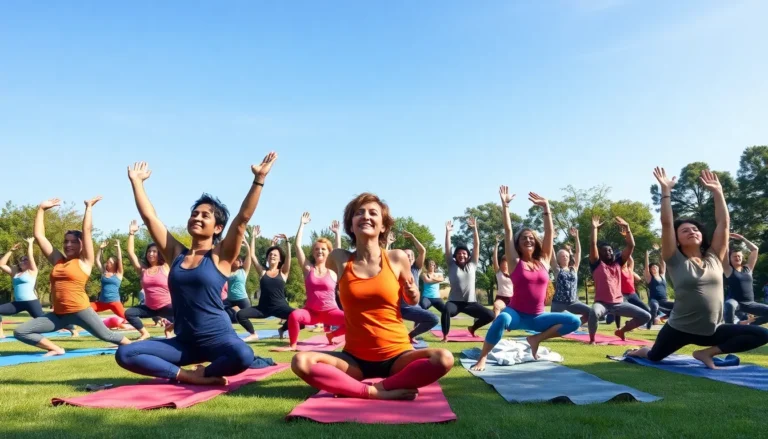Table of Contents
ToggleWhen it comes to shedding those pesky pounds, the great outdoors is calling. Forget the gym’s fluorescent lights and sweaty air—nature offers the perfect backdrop for weight loss exercises that are as refreshing as they are effective. Imagine trading the treadmill for a scenic trail or swapping dumbbells for a sturdy tree branch. Who knew losing weight could feel like an adventure?
Overview of Weight Loss Exercises Outdoors
Engaging in outdoor exercises offers numerous benefits for weight loss. Nature often provides a stimulating environment, encouraging longer and more enjoyable workouts. Many individuals find that hiking on scenic trails can lead to significant calorie burn—approximately 430 to 480 calories per hour, depending on intensity and terrain.
Using outdoor elements can enhance workouts as well. For example, tree branches serve as effective tools for strength training, allowing for exercises like pull-ups and dips. Parks often feature benches, which facilitate bodyweight exercises such as step-ups and tricep dips, promoting muscle engagement.
Running or jogging on varied terrain not only challenges the body but also contributes to improved cardiovascular health. Individuals can burn around 480 to 600 calories per hour while running at a moderate pace. Opting for trails instead of pavement can reduce impact on joints, making it a safer choice for many.
Biking through nature also serves as an excellent form of exercise. It fosters lower body strength and improves endurance while burning approximately 400 to 600 calories per hour. Whether cycling along a riverside or through wooded areas, the experience remains visually rewarding.
Group activities, such as outdoor boot camps or yoga classes, enhance motivation. The social aspect of exercising outdoors encourages participants to push themselves further, creating a supportive community. Classes often combine cardio and strength, maximizing calorie expenditure.
Focusing on outdoor exercises not only leads to weight loss but also enhances mental well-being. Exposure to fresh air and natural light boosts mood and motivation, making the fitness journey more enjoyable. Adopting a holistic approach to outdoor exercise can yield significant lifestyle benefits and long-term success in weight management.
Benefits of Outdoor Workouts

Outdoor workouts offer unique advantages that enhance both physical and mental wellness. Engaging in exercise in nature encourages a more profound connection to surroundings, promoting overall satisfaction.
Mental Health Benefits
Exercising outdoors significantly elevates mood by providing exposure to sunlight and fresh air. Studies show that natural environments can reduce stress levels and anxiety, helping individuals feel calmer. Regular outdoor activities can increase endorphins, fostering a sense of happiness. Individuals often report improved focus and mental clarity after fresh air workouts. Community-driven activities, like group exercises, enhance social connections, further supporting mental resilience.
Physical Health Benefits
Outdoor workouts greatly contribute to overall physical fitness, promoting cardiovascular health and muscle strength. Engaging in activities such as hiking or running typically burns 430 to 600 calories per hour, depending on intensity. Natural terrains challenge muscles differently, promoting strength adaptation. Additionally, outdoor spaces often encourage longer workout durations due to their scenic appeal. Improved vitamin D absorption from sunlight also supports bone health and immune function. Embracing outdoor exercises leads to better endurance and fitness levels, enhancing weight loss efforts.
Popular Weight Loss Exercises Outdoors
Outdoor workouts offer diverse options that make weight loss both effective and enjoyable. Engaging in various activities can significantly boost calorie burn while connecting with nature.
Running and Jogging
Running and jogging serve as excellent outdoor exercises for weight loss. On average, these activities can burn approximately 480 to 600 calories per hour, depending on intensity and terrain. Paths with varied landscapes challenge the body, improving cardiovascular fitness. Running not only enhances endurance but also promotes overall health. Regularly incorporating this exercise into a routine fosters quicker weight loss results.
Hiking
Hiking stands out as a unique outdoor activity that combines adventure with fitness. Typically, hiking can burn 430 to 480 calories per hour, varying based on trail difficulty and elevation. Natural surroundings add excitement, encouraging longer durations on the trails. Engaging with nature enhances well-being, making hiking a sustainable choice for weight loss. With diverse terrains, hikers can continually challenge themselves while enjoying scenic views.
Cycling
Cycling offers a fun way to burn calories while enjoying the outdoors. Riders can expect to burn between 400 to 600 calories per hour, influenced by speed and terrain. Cycling in picturesque environments not only aids weight loss but also boosts mental health. Options for both leisurely rides and intense cycling sessions cater to various fitness levels. Adopting cycling as part of a fitness routine can yield significant health benefits.
Bodyweight Exercises
Bodyweight exercises utilize natural elements and body resistance for effective workouts. Outdoor settings provide benches and tree branches for push-ups, squats, and tricep dips. These exercises can enhance strength while burning calories effectively. Incorporating bodyweight routines into outdoor workouts allows individuals to target multiple muscle groups. Furthermore, sessions in fresh air contribute to better mental clarity and focus during exercise.
Tips for Effective Outdoor Workouts
Outdoor workouts require thoughtful planning. Proper preparation maximizes benefits while ensuring safety and comfort in various settings.
Choosing the Right Location
Choosing the right location significantly impacts workout quality. Parks, beaches, and scenic trails provide engaging backdrops that enhance the exercise experience. A consistent choice of location helps build a routine and offers convenience. For instance, trails with varying difficulty levels provide challenges that increase intensity while enjoying nature. Seek out areas with adequate space to perform exercises freely. Look for locations where foot traffic is minimal, allowing for a more focused session. By prioritizing select outdoor environments, individuals can boost motivation and enjoyment.
Proper Gear and Equipment
Proper gear and equipment ensure comfort and safety during outdoor workouts. Selecting supportive footwear minimizes injury risks and enhances performance during running or hiking activities. Opt for moisture-wicking clothing to regulate body temperature and improve overall comfort level. Utilizing portable equipment, such as resistance bands or a yoga mat, can enhance outdoor workouts with added versatility. Additionally, incorporating hydration packs or water bottles sustains energy levels during longer sessions. Remember to apply sunscreen to protect skin from harmful sun exposure during daytime workouts. With appropriate gear, individuals promote a safer and more effective outdoor workout experience.
Safety Considerations
Outdoor exercise involves specific safety precautions to ensure a positive experience. Understanding weather conditions and maintaining hydration play crucial roles in health during workouts.
Weather Conditions
Planning workouts according to weather conditions significantly impacts safety and enjoyment. Sunlight exposure during workouts can enhance mood but also increases the risk of dehydration and heat exhaustion. Exercisers should check forecasts for temperature, wind, and precipitation to avoid unsafe conditions. Dressing in layers helps manage fluctuations in temperature. Warm weather gear focuses on moisture-wicking fabrics that improve comfort. On cooler days, breathable layers keep the body warm yet ventilated. Rainy or stormy conditions demand awareness due to slippery surfaces or potential lightning. Exercising during cooler parts of the day, like mornings or evenings, adds extra comfort and safety.
Staying Hydrated
Hydration is essential during outdoor workouts to maintain performance and prevent fatigue. Drinking water before, during, and after exercise aids in temperature regulation and maintains energy levels. A good rule includes drinking at least 8 ounces of water prior to workouts, with additional sips during exercise based on duration and intensity. In hot weather, experts recommend aiming for 3 to 8 ounces every 15 to 20 minutes during workouts. Carrying a water bottle provides easy access to fluids. Recognizing signs of dehydration, such as dry mouth or dizziness, ensures timely action. Proper hydration supports overall performance and enhances recovery after exercise, promoting effective weight loss.
Embracing outdoor exercises for weight loss opens a world of possibilities that extend beyond traditional workouts. The combination of fresh air scenic views and natural elements transforms fitness into an adventure. Participants not only burn significant calories but also enhance their mental well-being through exposure to nature.
By incorporating activities like hiking cycling and bodyweight exercises into their routines individuals can achieve their weight loss goals while enjoying the benefits of a healthier lifestyle. The social aspect of group workouts further enriches this experience fostering motivation and community support.
Choosing the right outdoor setting and prioritizing safety ensures a fulfilling and effective workout. With the right mindset and approach outdoor exercises can lead to lasting results and a deeper connection to both fitness and the environment.







